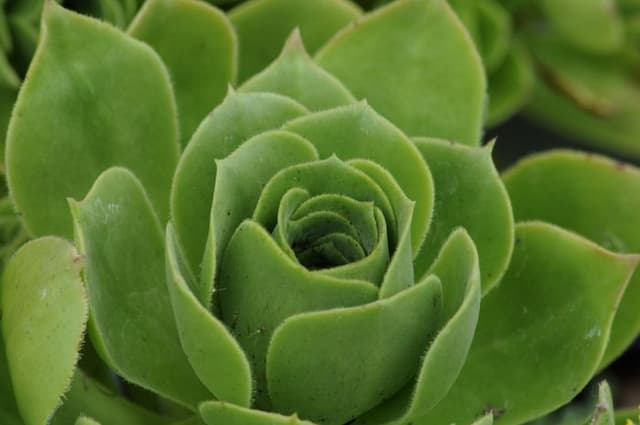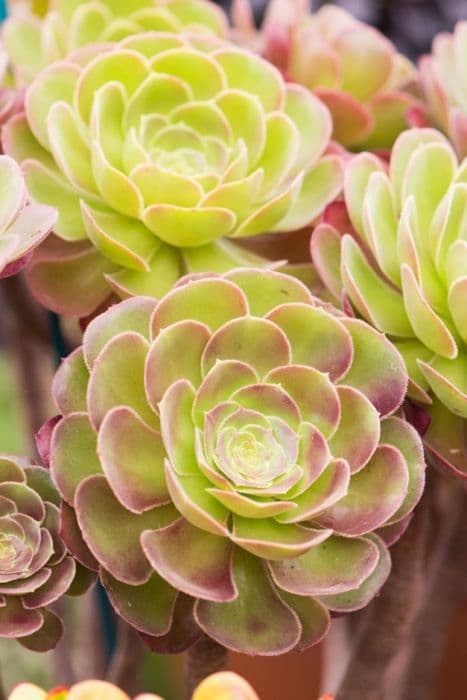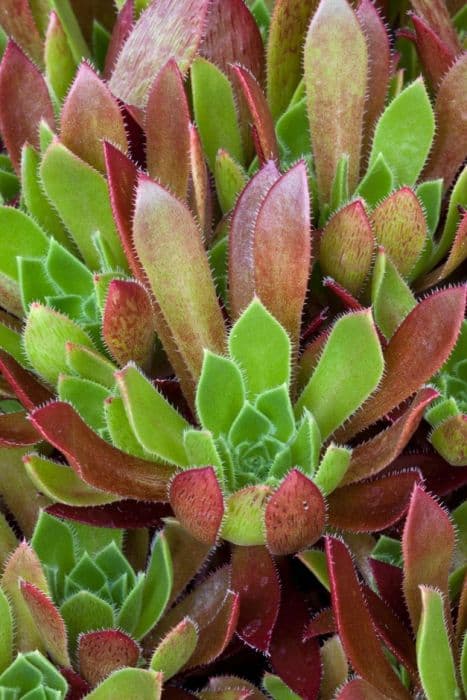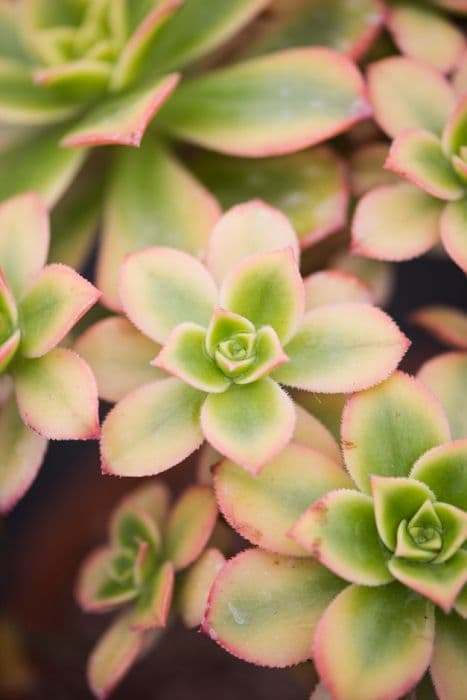Stonecrop Hylotelephium telephium (Atropurpureum Group) 'Karfunkelstein'

ABOUT
The plant known commonly as Stonecrop 'Karfunkelstein' boasts succulent, fleshy leaves that have a deep plum to purple coloration, adding a touch of rich hues to the garden. As the seasons change, so does the intensity of its leaf color, sometimes deepening in vibrancy. The leaves are arranged in a rosette-like pattern, giving it a full, lush appearance. During the blooming season, Stonecrop 'Karfunkelstein' produces clusters of small, star-shaped flowers. These blossoms are a striking pink to red color, creating a beautiful contrast against the dark foliage. The flowers are tightly packed atop sturdy, upright stems, creating a visual effect reminiscent of a colorful, textured carpet. This plant has a sturdy habit, with its fleshy leaves being its most distinguished trait. It is a popular choice for rock gardens, borders, and as a ground cover due to its visually attractive characteristics and its ability to thrive in a variety of garden settings.
About this plant
 Names
NamesFamily
Crassulaceae
Synonyms
Orpine, Livelong, Frog's-stomach, Harping Johnny, Life-everlasting, Live-forever, Midsummer-men, Orphan John, Witch's Moneybags
Common names
Sedum telephium 'Karfunkelstein', Hylotelephium 'Herbstfreude' 'Karfunkelstein'.
 Toxicity
ToxicityTo humans
The plant commonly known as Stonecrop is generally considered non-toxic to humans. However, consuming any part of this plant in large quantities may cause mild digestive upset or irritation in some individuals. There are no severe toxicity symptoms or life-threatening consequences associated with ingestion of Stonecrop in humans reported.
To pets
Stonecrop is also generally recognized as non-toxic to pets. If a pet were to ingest a large amount of the plant, they might experience gastrointestinal upset, such as vomiting or diarrhea. These symptoms should be mild and typically would not result in severe poisoning or long-term health consequences.
 Characteristics
CharacteristicsLife cycle
Perennials
Foliage type
Deciduous
Color of leaves
Purple
Flower color
Pink
Height
1-2 feet (30-60 cm)
Spread
1-2 feet (30-60 cm)
Plant type
Succulent
Hardiness zones
3-9
Native area
Europe
Benefits
 General Benefits
General Benefits- Drought Tolerance: Strong resistance to dry conditions once established, reducing the need for frequent watering.
- Low Maintenance: Requires minimal care, perfect for gardeners seeking plants with less upkeep.
- Attracts Pollinators: Flowers provide a food source for bees, butterflies, and other beneficial insects, enhancing pollination in the garden.
- Seasonal Interest: Offers visual appeal throughout multiple seasons with colorful foliage and flowers.
- Erosion Control: Capable of stabilizing soil and preventing erosion on slopes or in rocky areas.
- Edible Parts: Some parts of the plant are edible and can be used in salads or as garnishes, though care should be taken to correctly identify and prepare them.
- Easy Propagation: Can be easily propagated from cuttings or leaves, allowing gardeners to expand their collection without additional cost.
- Winter Hardy: Able to withstand cold temperatures, making it suitable for gardens in a variety of climates.
 Medical Properties
Medical PropertiesThis plant is not used for medical purposes.
 Air-purifying Qualities
Air-purifying QualitiesThis plant is not specifically known for air purifying qualities.
 Other Uses
Other Uses- Education: The distinct color and form of Sedum 'Karfunkelstein' can be used in botany classes to teach plant identification and characteristics of the Crassulaceae family.
- Photography: The vivid hues of Sedum 'Karfunkelstein' provide a stunning subject for photographers specializing in plant and garden photography.
- Art supplies: Artists may use the dried stems and flowers to create botanical collages or as an organic element integrated into mixed-media artwork.
- Dye production: The pigments in the leaves and flowers could potentially be used to produce natural dyes for coloring textiles or crafting materials.
- Cooking: Edible Sedum species, including 'Karfunkelstein', can add a peppery flavor to salads, though they should be used sparingly due to their intense taste.
- Flower arrangements: Sturdy and long-lasting, Sedum 'Karfunkelstein' can be integrated into fresh or dried floral arrangements, adding a splash of color and texture.
- Garden design: Used in xeriscaping, Sedum 'Karfunkelstein' helps create water-efficient gardens, requiring little water once established.
- Cultural symbolism: In some cultures, Sedum plants can be seen as symbols of tranquility and resilience, suitable for themed gardens or as gifts.
- Roof greening: Due to its hardiness and low-maintenance nature, Sedum 'Karfunkelstein' is ideal for green roof installations in urban areas.
- Wildlife habitat: Sedum 'Karfunkelstein' can provide nectar for bees, butterflies, and other beneficial insects, thereby enhancing biodiversity in gardens.
Interesting Facts
 Feng Shui
Feng ShuiSedum is not used in Feng Shui practice.
 Zodiac Sign Compitability
Zodiac Sign CompitabilitySedum is not used in astrology practice.
 Plant Symbolism
Plant Symbolism- Resilience: Hylotelephium telephium, commonly known as Stonecrop, often symbolizes resilience due to its ability to thrive in harsh conditions and poor soils.
- Longevity: The longevity of Stonecrop, which can live for several years, represents durability and the passage of time.
- Adaptability: Its adaptability to different environments stands for versatility and the capacity to adjust to life's changes.
- Tenacity: Stonecrop's tenacious hold on rocky surfaces symbolizes persistence and a strong will.
 Water
WaterStonecrop 'Karfunkelstein' requires minimal watering as it is a drought-tolerant succulent. During the growing season in spring and summer, water it once every 7 to 10 days, allowing the soil to dry out completely between waterings. Provide a thorough watering, ensuring that water reaches the roots, but avoid waterlogging. In the fall and winter months, reduce watering frequency to once every 2-3 weeks, as the plant enters a dormant state. Typically, use about half a gallon for an outdoor plant and 8-16 ounces for smaller indoor pots depending on the size of the plant and pot, adjusting for rainfall and humidity levels.
 Light
LightFor Stonecrop 'Karfunkelstein', the ideal lighting condition is full sun to partial shade. It thrives best in a spot that receives at least 6 hours of direct sunlight daily. However, it can tolerate partial shade, especially in the afternoon during the hottest part of the day. Avoid deep shade, as this can lead to poor growth and a lack of vibrant foliage color.
 Temperature
TemperatureStonecrop 'Karfunkelstein' is best grown in temperatures ranging from 60 to 75 degrees Fahrenheit, but it can withstand temperatures down to freezing and up to 90 degrees Fahrenheit for short periods. It is a hardy perennial that can survive winters with temperatures as low as 20 degrees Fahrenheit. The ideal temperatures shouldn't drop below 30 degrees Fahrenheit regularly to maintain its health and vitality.
 Pruning
PruningStonecrop 'Karfunkelstein' should be pruned to remove spent flower stems in late fall or early winter after blooming to maintain a neat appearance. Additionally, pruning can rejuvenate the plant by encouraging fresh growth in spring. It is not necessary to prune frequently; once a year is generally enough. The best time for pruning Stonecrop is after flowering, when the stems have dried out or in early spring before new growth begins.
 Cleaning
CleaningAs needed
 Soil
SoilSedum 'Karfunkelstein' thrives in a well-draining soil mix with a pH around 6.0 to 7.5. A blend of one part potting soil, one part coarse sand, and a handful of perlite or pumice is ideal, ensuring good drainage and aeration around its roots.
 Repotting
RepottingSedum 'Karfunkelstein' typically requires repotting every 2-3 years, or when it outgrows its current pot. Spring is the best time for repotting this succulent to allow for vigorous growth.
 Humidity & Misting
Humidity & MistingSedum 'Karfunkelstein' prefers low to average humidity levels and is very tolerant of dry conditions. Overly humid environments should be avoided as they may promote rot and fungal diseases.
 Suitable locations
Suitable locationsIndoor
Place in bright light, avoid overwatering, and ensure pot has drainage.
Outdoor
Full sun to part shade, well-draining soil, frost-resistant.
Hardiness zone
3-9 USDA
 Life cycle
Life cycleHylotelephium telephium (Atropurpureum Group) 'Karfunkelstein', commonly known as Stonecrop, begins its life as a small seed, which, with adequate moisture and temperature, germinates in the spring. The seedling emerges and grows into a succulent plant with fleshy leaves, developing a strong root system. As the plant matures, it forms a robust, clump-forming perennial that withstands both drought and poor soil conditions. During the summer, Stonecrop produces clusters of tiny, star-shaped flowers that attract pollinators and are typically a reddish-pink color. After flowering, the plant sets seed and the above-ground parts may die back in the fall, while the root system remains alive underground. The plant overwinters as roots and regrows the following spring, continuing its perennial cycle.
 Propogation
PropogationPropogation time
Spring to Summer
The most popular method of propagation for Hylotelephium telephium 'Karfunkelstein', commonly known as Stonecrop, is through stem or leaf cuttings. This is usually performed in spring or early summer when the plant's growth is most active. To propagate, a healthy stem section about 2 to 4 inches long (5-10 cm) is cut using a clean, sharp knife or scissors. The cut end is allowed to callous over for a few days to prevent rotting when planted. After the end has dried, the cutting is placed in well-draining soil and kept lightly moist. Rooting occurs typically within a few weeks, after which the new Stonecrop can be treated like a mature plant.









